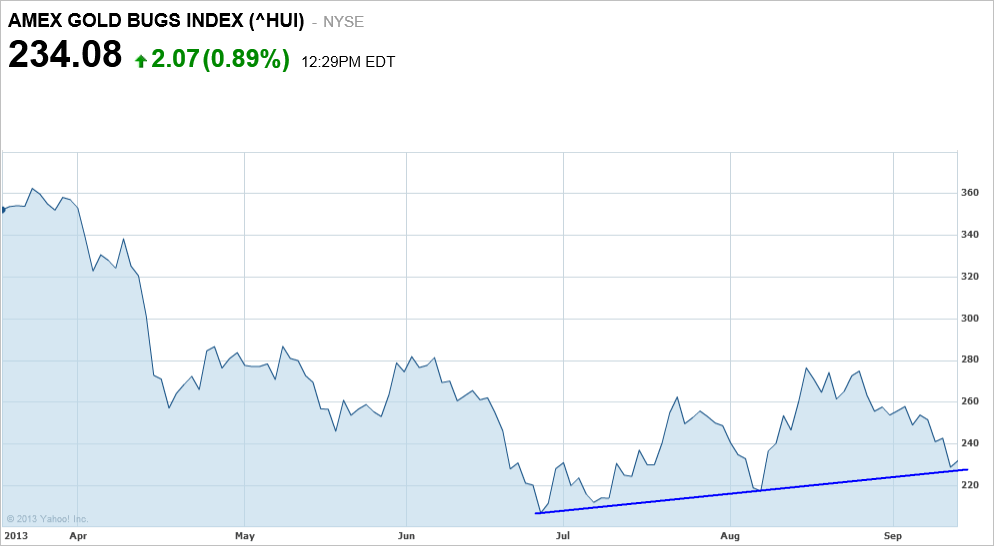Get Rich Slow Schemes in Gold Mining
Post on: 4 Июнь, 2015 No Comment

Here's why these stock prices don't entirely depend on gold prices
Get Rich Slow Schemes in Gold Mining
The Gold Report interviews Joe Mazumdar of Canaccord Genuity.
The Gold Report: A strange thing happened over the last few months. The price of gold went down, but some of the junior mining equities are up. Can you explain what is going on?
Joe Mazumdar: Year-to-date gold is flat. But the Market Vectors Junior Gold Miners ETF (GDXJ ) is up 13%. Investors prefer owning the equity now rather than owning gold. This was not the case a couple of years ago when gold was going up to $1,900 an ounce ($1,900/oz) and far outperforming equities. Part of the reason was investors didn t believe gold could maintain that level, which suggests that equities were overvalued at the time. Now the overall thesis is that gold has bottomed and the equities are undervalued. We dont believe all mining equities are undervalued, but there are some with management teams that can deliver the goods, whether its in exploration, development or production, and are seeing a premium for their projects that make sense.
The limited amount of capital in the sector is going to companies that can tick all the boxes. This is leading to kurtosis in the distribution of financing opportunities. The majority of companies don t have any means of attracting financing, while others are attracting more than they asked for.
TGR: Are you saying companies that are fully funded are, in a sense, immune to the gold price drop?
JM: Immune would be too strong a word. I would say companies that are fully funded to production such as Rubicon Minerals Corp. (RBY ), Roxgold (ROGFF ), Asanko Gold (AKG ), Torex Gold Resources (TORXF ), Midway Gold (MDW ) and, potentially, Golden Queen Mining (GQMNF ) are less susceptible to changes in their equity prices in the near term. The gold price doesnt impact them as much as it does companies that have not financed themselves to production. These companies have managed to raise the funds to bring their respective development projects into production through various means including equity, offtake agreements, joint ventures and vanilla debt facilities with hedging components.
Funded developers are in good shape because the financing risk their competitors face is a positive for them, as it reduces the amount of stress on resources required to build and operate projects while lowering the risk of capital escalation. The lower stress on project development is also helped by the limited amount of significant greenfield projects to be built by majors, as they focus on near-mine, brownfield projects. We note that Gold Fields (GFI ) has sold greenfield assets and reapplied those funds to brownfields projects and strengthening its balance sheet.
In our opinion, that makes it a great environment for those few that can attract financing to get a project into production because they are seeing limited capital escalation. They have access to better labor pools with the top people for engineering, procurement and construction management, and have a higher availability of contractors and equipment, generating lower lead times. In fact, many are actually squeezing the supply chain distributors for value.
Terraco Gold Corp. has royalties on the northern part of the Spring Valley project, where the majority of the current resource lies.
The companies that don t have the money going into this kind of gold price environment will have to be patient. Some have just enough working capital to keep the lights on. But, in our opinion, investors should seek companies that are funded to generate significant catalysts going forward.
Another category is companies advanced exploration stories that are derisking projects through technical studies and permitting. This includes Orezone Gold (ORZCF ) and Dalradian Resources (DRLDF ).
Orezone will seek funds to develop its Bomboré open-pit, heap-leach gold project in Burkina Faso, West Africa, once it completes the feasibility study (Q4/14E) and acquires the exploitation permit (2015). The management team knows how to derisk a project and, in our opinion, would be able to attract financing because investors believe they can take the project to the next level.
Dalradian Resources is currently funded to complete a bulk tonnage sampling program at their high-grade, underground gold project (Curraghinalt) in Northern Ireland. The company recently closed an upsized and over-allotted equity financing for
CA$27M, which will be used to advance the Curraghinalt project through permitting and a final project description to the end of 2016. We anticipate an updated scoping study prior to year end.
In comparison, Goldrock Mines (MFMNF ) has a permitted project (Lindero) with a feasibility study, but has to contend with the significant geopolitical risk pervading Argentina. I m not saying it s impossible to fund the projects development but, in our opinion, the potential financing avenues available for the company may be more limited and egregious than for a company working in a more manageable jurisdiction.














